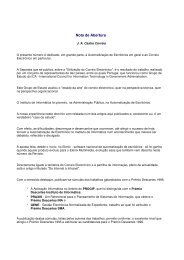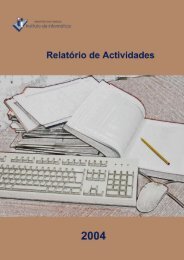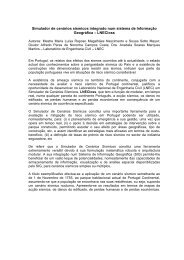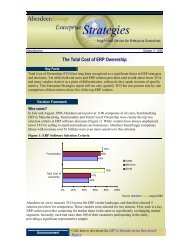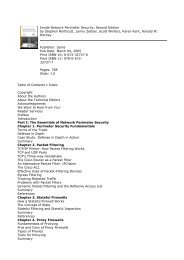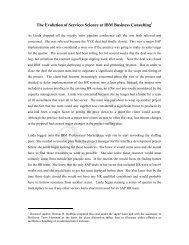OECD Peer Review of E-Government in Denmark - ePractice.eu
OECD Peer Review of E-Government in Denmark - ePractice.eu
OECD Peer Review of E-Government in Denmark - ePractice.eu
Create successful ePaper yourself
Turn your PDF publications into a flip-book with our unique Google optimized e-Paper software.
Adm<strong>in</strong>istrative environment<br />
Organisation <strong>of</strong> State and local government<br />
The Danish public sector is divided <strong>in</strong>to State and local government. State government is<br />
comprised <strong>of</strong> both national and local functions and services. The structure <strong>of</strong> local government is<br />
(currently) based on a two-tier system <strong>of</strong> counties and municipalities, where municipalities “belong” to<br />
one <strong>of</strong> the counties. However, the general rule is that the counties are not superior to the municipalities<br />
– they each have their own sphere <strong>of</strong> responsibility.<br />
The public sector <strong>in</strong> <strong>Denmark</strong> is characterized by its very decentralized structure and<br />
management. Local authority <strong>in</strong>dependence is established <strong>in</strong> the Danish Constitution, and many<br />
adm<strong>in</strong>istrative powers are delegated to the 14 counties and the 275 local authorities <strong>in</strong>to which<br />
<strong>Denmark</strong> is currently (June 2005) divided; the municipalities <strong>of</strong> Copenhagen and Frederiksberg each<br />
have the dual status <strong>of</strong> municipality and county. The current <strong>Government</strong> is push<strong>in</strong>g forward with the<br />
“Structural Reform”, which will replace the 14 counties with 5 regions, and reduce the 275 local<br />
authorities to around 98.<br />
The Danish public sector is very large. In the third quarter <strong>of</strong> 2004 the breakdown <strong>of</strong> public sector<br />
employment was: total Danish workforce, 2,188,000; total public sector workforce, 839,000 (38%);<br />
municipality workforce, 431,000; county workforce, 176,000; central government workforce, 54,300;<br />
public corporations, 78,500.<br />
State government<br />
The functions <strong>of</strong> State government are divided <strong>in</strong>to m<strong>in</strong>isterial portfolios which def<strong>in</strong>e the<br />
structure <strong>of</strong> Danish m<strong>in</strong>istries. In pr<strong>in</strong>ciple, m<strong>in</strong>isters make all decisions that fall with<strong>in</strong> a m<strong>in</strong>istry’s<br />
responsibilities. In practice many decision-mak<strong>in</strong>g powers are delegated to various adm<strong>in</strong>istrative<br />
bodies. The top-level <strong>of</strong> adm<strong>in</strong>istration <strong>in</strong> a m<strong>in</strong>istry, serv<strong>in</strong>g as the day-to-day advisor to the m<strong>in</strong>ister,<br />
is called the M<strong>in</strong>isterial Department.<br />
Directorates and agencies are the general terms for the State government bodies belong<strong>in</strong>g to a<br />
m<strong>in</strong>istry. Normally, their function is to make decisions and carry out functions with<strong>in</strong> a specified area<br />
and to advise the M<strong>in</strong>isterial Department and the m<strong>in</strong>ister. Directorates and agencies are usually<br />
subord<strong>in</strong>ate to the M<strong>in</strong>isterial Department, but <strong>in</strong> some cases they have a more <strong>in</strong>dependent position.<br />
State government at sub-national levels<br />
State government is represented at the sub-national level through local branches <strong>of</strong> central<br />
government organisations that provide nationwide services (i.e. the police, the prison service, and the<br />
post <strong>of</strong>fice), and <strong>in</strong>stitutions or bodies that provide localised services (i.e. universities, regional<br />
archives, the lifeboat service, etc.).<br />
Currently, at the local government level there are 14 County Prefect Offices (Statsamter), which<br />
cover the same geographical area as the counties. The prefect (Statsamtmand) is nom<strong>in</strong>ated by the<br />
State government. The ma<strong>in</strong> task <strong>of</strong> the prefect’s <strong>of</strong>fice is to make decisions concern<strong>in</strong>g family law. It<br />
also acts as the secretariat for the County Board <strong>of</strong> Appeal, which exam<strong>in</strong>es decisions made by<br />
municipalities on social questions.<br />
Municipalities are subject to specific legislation, operate under a presumption <strong>of</strong> powers <strong>of</strong><br />
“general competence”, and are overseen by the M<strong>in</strong>istry <strong>of</strong> the Interior and Health and 14 County<br />
164



